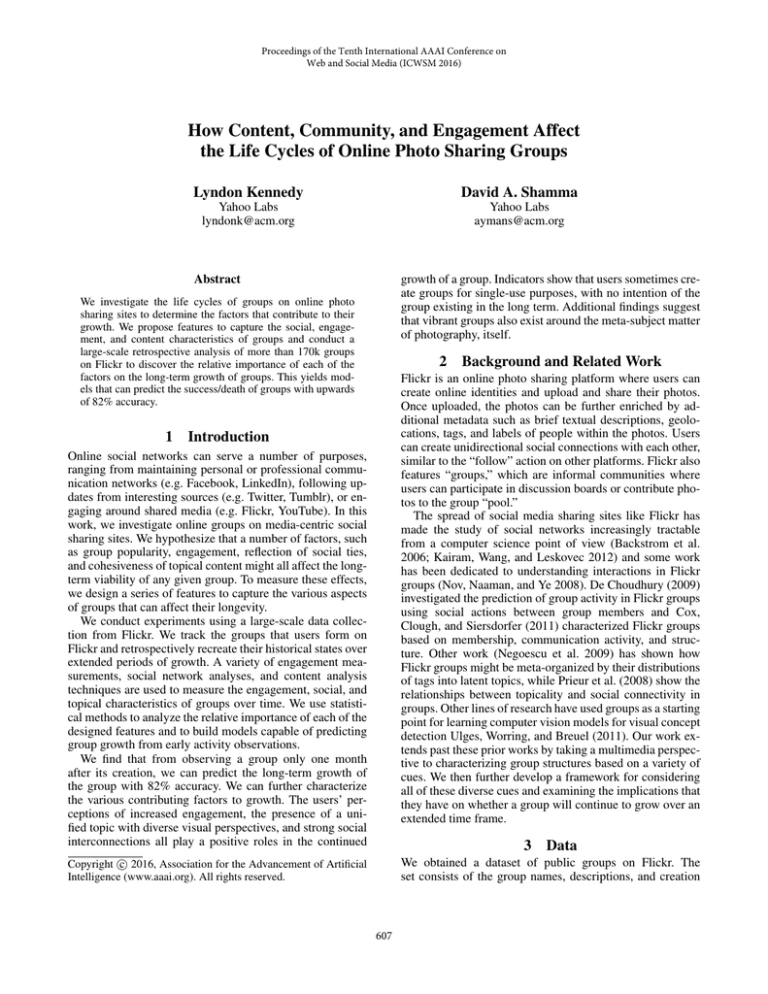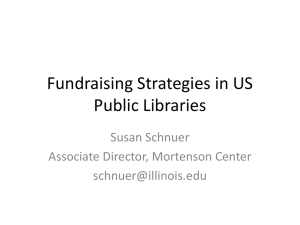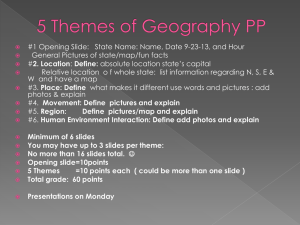
Proceedings of the Tenth International AAAI Conference on
Web and Social Media (ICWSM 2016)
How Content, Community, and Engagement Affect
the Life Cycles of Online Photo Sharing Groups
Lyndon Kennedy
David A. Shamma
Yahoo Labs
lyndonk@acm.org
Yahoo Labs
aymans@acm.org
growth of a group. Indicators show that users sometimes create groups for single-use purposes, with no intention of the
group existing in the long term. Additional findings suggest
that vibrant groups also exist around the meta-subject matter
of photography, itself.
Abstract
We investigate the life cycles of groups on online photo
sharing sites to determine the factors that contribute to their
growth. We propose features to capture the social, engagement, and content characteristics of groups and conduct a
large-scale retrospective analysis of more than 170k groups
on Flickr to discover the relative importance of each of the
factors on the long-term growth of groups. This yields models that can predict the success/death of groups with upwards
of 82% accuracy.
1
2
Background and Related Work
Flickr is an online photo sharing platform where users can
create online identities and upload and share their photos.
Once uploaded, the photos can be further enriched by additional metadata such as brief textual descriptions, geolocations, tags, and labels of people within the photos. Users
can create unidirectional social connections with each other,
similar to the “follow” action on other platforms. Flickr also
features “groups,” which are informal communities where
users can participate in discussion boards or contribute photos to the group “pool.”
The spread of social media sharing sites like Flickr has
made the study of social networks increasingly tractable
from a computer science point of view (Backstrom et al.
2006; Kairam, Wang, and Leskovec 2012) and some work
has been dedicated to understanding interactions in Flickr
groups (Nov, Naaman, and Ye 2008). De Choudhury (2009)
investigated the prediction of group activity in Flickr groups
using social actions between group members and Cox,
Clough, and Siersdorfer (2011) characterized Flickr groups
based on membership, communication activity, and structure. Other work (Negoescu et al. 2009) has shown how
Flickr groups might be meta-organized by their distributions
of tags into latent topics, while Prieur et al. (2008) show the
relationships between topicality and social connectivity in
groups. Other lines of research have used groups as a starting
point for learning computer vision models for visual concept
detection Ulges, Worring, and Breuel (2011). Our work extends past these prior works by taking a multimedia perspective to characterizing group structures based on a variety of
cues. We then further develop a framework for considering
all of these diverse cues and examining the implications that
they have on whether a group will continue to grow over an
extended time frame.
Introduction
Online social networks can serve a number of purposes,
ranging from maintaining personal or professional communication networks (e.g. Facebook, LinkedIn), following updates from interesting sources (e.g. Twitter, Tumblr), or engaging around shared media (e.g. Flickr, YouTube). In this
work, we investigate online groups on media-centric social
sharing sites. We hypothesize that a number of factors, such
as group popularity, engagement, reflection of social ties,
and cohesiveness of topical content might all affect the longterm viability of any given group. To measure these effects,
we design a series of features to capture the various aspects
of groups that can affect their longevity.
We conduct experiments using a large-scale data collection from Flickr. We track the groups that users form on
Flickr and retrospectively recreate their historical states over
extended periods of growth. A variety of engagement measurements, social network analyses, and content analysis
techniques are used to measure the engagement, social, and
topical characteristics of groups over time. We use statistical methods to analyze the relative importance of each of the
designed features and to build models capable of predicting
group growth from early activity observations.
We find that from observing a group only one month
after its creation, we can predict the long-term growth of
the group with 82% accuracy. We can further characterize
the various contributing factors to growth. The users’ perceptions of increased engagement, the presence of a unified topic with diverse visual perspectives, and strong social
interconnections all play a positive roles in the continued
3
c 2016, Association for the Advancement of Artificial
Copyright Intelligence (www.aaai.org). All rights reserved.
Data
We obtained a dataset of public groups on Flickr. The
set consists of the group names, descriptions, and creation
607
4.4
timestamps. This also includes all group members, all photos added to the group, and the respective timestamps of
members joining and photos being added. We also gather
timestamped social connections between users and additional metadata about the photos, such as their tags, the images, and the activity (views, comments, favorites) that they
have received. From this dataset, we can retrospectively construct views of groups and how they were composed of people and media at any historical point in time by applying
thresholds on timestamps for members joining and photos
being added with respect to the time of groups creation. We
limit our analyses to the public groups that have accumulated more that 50 photos in their pool in the first month
since the founding of the group. This yields more than 174k
groups spanning the past 12 years (since Flickr’s launch).
4
4.1
The degree to which photos in a group are related to a single
visual topic might also reflect the lifespan of the group.
Visual Diversity We represent the content of the images
in by applying computer vision (Krizhevsky, Sutskever, and
Hinton 2012) to create classifiers for common concepts
(such as “cat,” “wedding,” “graffiti,” etc.), yielding models
for more than 1500 visual concepts. Each image in each
group in our dataset is then passed through this pipeline,
giving us a set of automatic “visual concepts.” We calculate a multinomial distribution of these visual concepts in the
i)
group as P (Vi ) = #(V
|VG | , where the probability of a photo
having visual concept i is estimated as that ratio of all photos
having visual concept i in the group pool, #(Vi ), to the total number of visual concepts detected over all photos in the
group, |VG |. We calculate the entropy of this distribution, as
above, to characterize the visual diversity of the group.
Predictor Features
Prior Growth
Groups that have more members and more photos might
continue to grow in the future. To measure this, we simply
take the increases in the number of members of the group
and the number of photos in the pool over the course of some
previous time period (for example, the past month).
4.2
Tag Diversity Flickr provides users with an easy way for
users to manually tag their photos. We calculate a multinoi)
mial distribution of tags in a group as P (Ti ) = #(T
|TG | , where
the probability of a photo having tag i is the ratio of all photos having tag i, #(Ti ), to the total number of tags applied
to photos in the pool, |TG |. We characterize this distribution,
again, by calculating the entropy.
Engagement Lift Features
A common reason that users participate in social media
sharing sites is to gain exposure and receive engagement
from other users. To measure this, we apply a method for
quantifying the rise in engagement that a user expects from
submitting a photo to a group. For each user, we examine
his/her public collection of photos and calculate the number of views, favorites, and comments that an average photo
would receive. For each photo in a given group, we calculate the ratio of the true number of views, favorites, or comments that the photo has received to the expected values of
these engagements for the owner of that photo. We aggregate these ratios over each photo in the group to measure the
expected lift in engagement that photos in the group have
compared to generic photos from each user.
4.3
Photo and Theme Coherence Features
4.5
Group Descriptive Terms
When users create groups on Flickr, they provide names and
descriptions for the group. We extract features related to the
terms used in these descriptions by some lightweight text
analysis. We tokenize the strings into unigrams and then further normalize them by stripping out punctuation and converting to lowercase letters. We limit our analysis to the approximately 4000 terms that have appeared in the names of
at least 100 of the 174k groups in our set.
5
5.1
Statistical Modeling
People, Topics, and Attention
To understand the relative predictive power of the features
that we have designed, we apply a logistic regression. We
specify the dependent variable as whether the group is growing in terms of photos added on a month-by-month basis faster or slower than the median after a period of one
year. The independent variables are defined by the abovedescribed measures of engagement, social connectivity, and
subject diversity. These independent variables, however, are
measured at the point in time when the group is only one
month old. The variables are all normalized (zero mean,
unit variance) such that the resulting coefficients are directly
comparable. Effectively, we are taking a short-term view of
a new group and seeing which measurable aspects of the
group will be predictive of its long-term staying power.
People and Identity Features
Factors related to the identity of group participants and their
relationships to each other might also affect group growth.
Contact Density We consider the structure of social connections between members of each group. We count the
number of social connections between group members and
take its ratio against this maximum value of connections in
a fully-connected graph composed of group members.
Owner Diversity To measure the diversity of group contributors, we calculate a multinomial distribution over the
owners of each of the photos that have been contributed to
the group’s pool as the probability of a photo coming from
owner P (Oi ) is the ratio of the number of photos contributed
by owner i, #(Oi ), to the total number of photos in the pool
i)
|G|, or P (Oi ) = #(O
|G| . We then characterize this distribution by calculating
the ownership entropy, H(O) using:
H(O) = − i P (Oi ) log(P (Oi )).
5.2
Descriptive Terms
Analyzing the relative predictive power of terms requires
the ability to incorporate many sparse predictors that may
be highly correlated. To achieve this, we adopt a penalized
608
β
-4.293
p
***
0.000
0.001
***
***
-0.008
0.631
0.009
*
***
**
Contact Density
Owner Entropy
0.562
0.498
***
***
Visual Diversity
Tag Diversity
0.360
0.470
***
***
Category
Intercept
Feature
Intercept
Prior Growth
Number of Photos
Number of Members
Engagement
Favorites
Views
Comments
People
Photos
p1, etsy, hdr, comment, photographers, colors, bw,
fujifilm, admin, hand, olympus, canon, toys,
postcards, panasonic, guess, 365, nikon, cats, blythe,
macro, 52, pentax, n, award, users, please, leica,
solo, yellow, trees, vintage, doll, artists, moments, il,
landscapes, lovely, japanese, rules, post, aircraft, fuji,
handmade, beautiful, dolls, flickrs, children, today,
portraits, etc, cars, trucks, animal, dogs, disney, uk,
ford, españa, british, flowers, daily, anything, flickr,
photographer, graffiti, perfect, lovers, mundo, views,
arte, trains, dark, pretty, passion, now, faces,
magazine, models, sony, random, photographs,
videos, wildlife, e, architecture, parks, birds, toy,
creations, lego, nature, buses, books, cat, fotografia,
bird, people, france, cute
*: p < 0.05, **: p < 0.01, ***: p < 0.001
Table 1: Coefficients of logistic regression for group growth
above the median after 1 year.
Table 2: The 100 strongest terms for predicting that that a
Flickr group will grow above median rate in 1 year.
logistic regression approach (Friedman, Hastie, and Tibshirani 2010), which can predict a binary dependent variable
while guarding against collinearity of independent variables.
Again, we set the dependent variable to be group growth rate
at one year and use input variables after one month of group
existence. Similar to Gilbert (2012), we code the terms as either present (1) or not present (0) in the description of each
group and learn the model using this joint feature space.
6
6.2
Participation. An interesting effect that we observe is the
appearance of terms around the expected engagement practices. One of the top terms is “comment,” which reflects that
some groups have rules where users posting photos are expected to add comments or favorites to other users’ photos in
order to incentivize participation (“please,” “post,” “views,”
and “rules” are also predictive terms related to this practice). Another participatory practice is giving awards to photographs (the “award” term appears in the list as does the
“n” glyph). Finally, we also note the appearance of terms
related to long-term group participation projects, such as
“365,” where users post a new photo on each day of the year,
or “52,” where new photos are posted every week. By their
nature these types of interactions predict sustained contributions over time periods much longer than just the first few
days or months of the group. Interestingly, this is at odds
with the above-described observation that increased in engagement due to groups are not strongly predictive of group
longevity. This may be due to the fact that these types of
rule-based groups might only increase the users’ perception
that the group is increasing engagement when it is not significantly increased in practice.
Results and Discussion
Table 1 shows the coefficients of the logistic regression.
We see that most factors are positively related to long-term
growth. Together, they predict growth with 82% accuracy.
6.1
Topics for Growth
We show the most predictive terms for long-term group
growth in Table 2 and discuss observed patterns below.
Predictive Features
We see that the propensity for a group to contribute positively to the overall engagement that a photograph receives
is somewhat positively predictive of the long-term growth
of the group. This observation supports the earlier hypothesis that exposure and engagement are important motivators
for any action taken on social media sharing sites.
The composition of the people that make up a group and
the distribution of their participation rates are both predictors of group longevity. The contact density of the social
graph of group participants is a strong predictor, which indicates that groups where users have established direct social
connections outside of the group have a higher long term
success rate. The degree of diversity in users submitting photos is also a strong predictor, indicating that stronger groups
are formed by diverse participants submitting photographs.
The topical diversity of the photos contributed to a group
pool, both in terms of the visual content of the photos and the
tags associated with them are predictive of long-term group
growth. Interestingly, in both cases, the more diverse a group
is in terms of its topical or visual content, the more likely it is
to have sustained long-term interest. This suggests that even
in the case of groups formed around single subject matters,
varied viewpoints are valued over repetitions of the same
perspectives.
Subject Matter as Interest. Many of the terms that appear to be predictive of group survival are related to shared
common interests and photographic subject matters. Some
examples of these are natural landscapes (“landscape,”
“flowers,” “wildife”), vehicles (“buses,” “trains,” “cars”),
and people (“portraits,” “models”). All of these suggest that
groups about single topics of interest are likely to grow. This
is at odds with our above-described finding that visual and
topical diversity are also predictive of success. This might
indicate that the types of photos in these groups are related
to similar topic matters, but show a diverse set of viewpoints
and perspectives on the subject.
609
predictive powers of each of these cues. This resulted in a
system capable of predicting group longevity with more than
82% accuracy. The analyses further yielded insights into the
relative importance of social connectivity within groups and
diverse contributions and viewpoints around topics of interest. Our investigation further uncovered indications of other
uses of groups, such as single-purpose groups for disseminating media between event attendees and the staying power
of groups formed around the media-creation process, itself,
rather than any other sort of social or topical connectivity.
anh, graduation, seo, 07, 2015, wedding, beckles,
reunion, birthday, 2012, 2014, 2013, 09, 2011, trip,
2007, 2010, 2008, 2006, 08, 2009, 2005, grade,
anniversary, jonas, workshop, website, camp, office,
chris, clan, course, annual, scott, chapter, vs, curso,
conference, program, family, photowalk, weekend,
marketing, ve, party, event, student, summit, march,
mission, foundation, rica, vacation, canyon, fall,
study, tour, david, period, training, soccer, basketball,
run, institute, class, team, walk, youth, 12, media,
tech, ball, swap, school, adventure, memorial,
celebration, august, june, exhibition, internet, fc, ski,
page, gang, competition, july, 13, portfolio, bar,
adventures, alumni, band, paul, ii, resort, hockey,
site, baseball, college
References
Backstrom, L.; Huttenlocher, D.; Kleinberg, J.; and Lan, X.
2006. Group formation in large social networks: Membership, growth, and evolution. In Proceedings of the 12th ACM
SIGKDD International Conference on Knowledge Discovery and Data Mining, KDD ’06, 44–54. New York, NY,
USA: ACM.
Cox, A.; Clough, P.; and Siersdorfer, S. 2011. Developing metrics to characterize flickr groups. Journal of the
American Society for Information Science and Technology
62(3):493–506.
De Choudhury, M. 2009. Modeling and predicting group
activity over time in online social media. In Proceedings
of the 20th ACM Conference on Hypertext and Hypermedia,
HT ’09, 349–350. New York, NY, USA: ACM.
Friedman, J.; Hastie, T.; and Tibshirani, R. 2010. Regularization paths for generalized linear models via coordinate
descent. Journal of statistical software 33(1):1.
Gilbert, E. 2012. Phrases that signal workplace hierarchy.
In Proceedings of the ACM 2012 Conference on Computer
Supported Cooperative Work, CSCW ’12, 1037–1046. New
York, NY, USA: ACM.
Kairam, S. R.; Wang, D. J.; and Leskovec, J. 2012. The
life and death of online groups: Predicting group growth and
longevity. In Proceedings of the Fifth ACM International
Conference on Web Search and Data Mining, WSDM ’12,
673–682. New York, NY, USA: ACM.
Krizhevsky, A.; Sutskever, I.; and Hinton, G. E. 2012.
Imagenet classification with deep convolutional neural networks. In Advances in Neural Information Processing Systems.
Negoescu, R.-A.; Adams, B.; Phung, D.; Venkatesh, S.; and
Gatica-Perez, D. 2009. Flickr hypergroups. In Proceedings
of the 17th ACM International Conference on Multimedia,
MM ’09, 813–816. New York, NY, USA: ACM.
Nov, O.; Naaman, M.; and Ye, C. 2008. What drives content
tagging: The case of photos on flickr. In Proceedings of
the SIGCHI Conference on Human Factors in Computing
Systems, CHI ’08, 1097–1100. New York, NY, USA: ACM.
Prieur, C.; Pissard, N.; Beuscart, J.-S.; Cardon, D.; and Pons,
P. 2008. Thematic and social indicators for flickr groups. In
ICWSM.
Ulges, A.; Worring, M.; and Breuel, T. 2011. Learning visual contexts for image annotation from flickr groups. Multimedia, IEEE Transactions on 13(2):330–341.
Table 3: The 100 strongest terms for predicting that that a
Flickr group will grow below median rate in 1 year.
Photography Practice as Interest. The high prevalence
of terms like “photographers,” “photographs,” and “fotografia” among the terms predictive of group growth is surprising since all groups are fundamentally grounded around
the sharing of photographic content. However, the fact that
these groups specifically reference the practice of photography is indicative of the importance of groups that cater to
the interests of photography hobbyists. This implies that an
important function of groups on a media-centric sharing site
like Flickr is for users who do not necessarily know each
other to connect socially around their shared enthusiasm for
the practice of photography.
6.3
Purposefully Short-Term Groups
In the results shown in Table 3, we see the terms that are
most negatively associated with long-term activity in groups.
We see overwhelmingly that these terms are temporal in nature, referring to specific events or points in time. Terms corresponding to years (“2015,” “2014,” “09,” etc.) as well as
months and seasons (“july,” “august,” “fall”) are among the
strongest negative terms. Terms related to common one-time
events (“graduation,” “wedding,” “reunion,”) are also strong
as are sporting events (“basketball,” “soccer,” “hockey”) and
terms related to vacations (“vacation,” “canyon,” “resort,”
“ski”). These effects are due to the practice of using Flickr to
create ad hoc groups for the purposes of sharing photos after an event between a number of users who may have been
in attendance, without any intention of creating a long-term
interest group. This might indicate the need for designing
tools that are more tuned to this specific use-case.
7
Conclusions
We have presented a large-scale investigation of social
groups on media-centric social networking services. We designed several methods for capturing the structure, composition, and engagement effects present in a group and implemented statistical analyses to understand and leverage the
610





